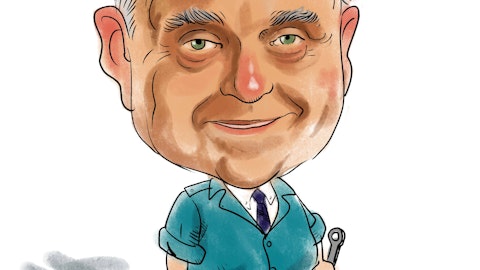Matthew Howlett: Look, I appreciate all the actions you’re taking and I certainly understand the ROEs you’re getting on the owned portfolio, maybe I’ll ask it a different way. Do you feel confident you can take the leverage profile, I think you said down in line with peers, those being what PennyMac and Cooper and Rithm? Do you feel like, Glen, over time — Glen or Sean, that you can bring it down to peer levels over a certain amount of time? Is that sort of the goal here?
Glen Messina: Yes. Look, the goal is to try to have a more normative capital structure and leverage ratio as compared to our peers. And look, we believe that’s the right priority for the business. We believe it’s the right way to allocate our capital on a go-forward basis to eliminate risk, potentially eliminate risk and volatility in our earnings. But look, as of now, look, it’s capital allocated — we review capital allocation all the time with the board. So as the market environment changes, we’ll continuously evaluate our capital allocation priorities and make the decisions that we think are most accretive to shareholders on a go-forward basis.
Matthew Howlett: No, look, you certainly deserve a multiple in line with those folks. So congrats on the progress you’re making. But on the subservicing, I mean, most of that is going to be through your third-party capital partners. I mean, do you have discussions — you’ve entered with subservicing with some banks in the past, sort of some negotiated transactions. Do you still have that in the pipeline where you could do — you could win business without your third-party capital partners, you kind of just go in and subservice a portfolio for a bank, call it?
Glen Messina: Yes. So we’ve got a variety of different client profile, so to speak, in our subservicing portfolio. So it would include banks, credit unions, independent mortgage banks and financial investors. Those are kind of the 4 towers essentially client profiles that we tend to look at. So yes, we’ve — we do subservicing today for banks. It’s good business, especially if it’s a smaller regional and community bank who’s got a couple of billion dollars in mortgages outstanding, really tough for them to service anywhere near a cost competitive profile to make MSR returns. That would be commensurate with their return objectives. So leveraging our subservicing capabilities with a larger scale platform with a more competitive cost structure is a good way for them to participate in offering a product to their consumers and not have the burden of the operating responsibilities.
Matthew Howlett: And that’s part of the guidance, right? I mean, you have some of those in the guidance or is that — is it also the third-party capital? Just curious whether that mix is going to include?
Glen Messina: It’s all in. So look, we don’t necessarily have established growth targets, so to speak, by each client profile that we discussed publicly. Our guidance on our expected growth in subservicing and what we believe we can achieve includes subservicing transactions from all client profile types.
Matthew Howlett: Got you. Great. And then last question, Sean, for you. It looks like you’re going to end the year profitable. And again, I always focus on that deferred tax asset. Did you release any reserve on that deferred tax asset this quarter? It doesn’t look like you did. And could you give us sort of the estimated size of it? And whether or not the outlook on releasing some of that reserve partially or fully because I know it is substantial?
Sean O’Neil: Yes. So we — to your — I’ll go backwards. To your last question, we don’t update our valuation allowance and total deferred tax asset, which is offset by the valuation allowance, except for annually. So you won’t see that except in the K. As of the last K, it was a little north of $107 million was the deferred tax asset. You’re going to see — you’ll have to see several more quarters of continued profitability before we can release that either partially or fully. So there have been no transactions that involve that other than just offsetting any existing profit with the net operating losses, but the valuation allowance has not been lifted to free up the deferred tax asset at this point.
Matthew Howlett: Got you. I’m sorry. And then you said it was 100 — remind me, you said it was $170 million or $107 million?




